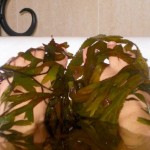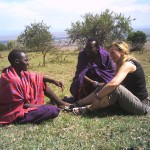 I had always resisted the idea of a safari holiday, wanting to avoid khaki-clad tourists stuck to the lenses of their cameras, desperate to get good shots, later sipping GTs in the bar while “locals” fan the flies away from them and their five courses. I stand well and truly corrected.
I had always resisted the idea of a safari holiday, wanting to avoid khaki-clad tourists stuck to the lenses of their cameras, desperate to get good shots, later sipping GTs in the bar while “locals” fan the flies away from them and their five courses. I stand well and truly corrected.
My fellow passengers on the 10-seater aircraft to the Masai Mara ranged from a French student to an elderly American priest, with no sign of designer luggage or colonial hangovers between them. We were headed for Olonana Camp, one of whose drivers, Lucas, met us at the airstrip and drove us on a 40-minute jeep ride to the lodge.
This was the best introduction to a country I could ever wish for. Lucas pointed out giraffes finishing off the dwindling branches of the acacias before the rains came to replenish their stocks. He explained how we were lucky to still see the wildebeest in late November, as they are usually tucked up in their Serengeti beds by now, exhausted from their annual 3,000km migration. But climate change meant their pastures were not ready for them yet, and nature was, somehow, helping them dally a little.
The sunset ignited the dusty red floor of the savannah, providing the perfect backdrop for the vibrant reds of the Masai men’s robes as they brought their cattle home to their villages for the night. Lucas, also Masai but from a village 60km away, stopped to speak to a few of the herdsmen, who shook hands with us all and with beaming smiles said: “Ingamuno.” Lucas translated: “You’re welcome.”
Such hospitality was to be the theme of the day. We were welcomed at Olonana with fruit cocktails on a veranda overlooking a river. Enter hippos on cue, about 10 of them within a few metres of us, splashing and writhing and looking, indeed, very happy to be hippos. The manager of Olonana, Minnie, should lead workshops in hospitality. Within 10 minutes of my arrival I was curled up on an outdoor sofa, and she had made me feel as if Olonana was home.
Ready to collapse for a couple of hours before dinner, I asked the guard who led me to my tent if he ever had to use the bow and arrow he was gripping. “It’s just for emergencies; don’t worry. There is a walkie-talkie by your bed if you need it, so just call.” I smiled in an attempt to conceal my anxieties about my first time sleeping with hippos and crocodiles a few metres away.
I have never been in a tent with hardwood floors or an ensuite bathroom before. Or two queen-sized beds, for that matter. There was even a hairdryer. Maybe they are all dressing for dinner after all, I thought. 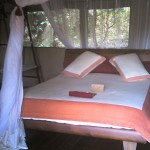 But rest assured, there is no dress code at Olonana. The only codes of practice they adhere to are environmental ones. There is solar lighting, and requests to monitor water usage. They have established a tree-planting project, aimed at curbing local deforestation, sourcing ecofriendly carbonised sawdust fuel in Nairobi. All bathroom products are biodegradeable, and hot water is limited to mornings and evenings.
But rest assured, there is no dress code at Olonana. The only codes of practice they adhere to are environmental ones. There is solar lighting, and requests to monitor water usage. They have established a tree-planting project, aimed at curbing local deforestation, sourcing ecofriendly carbonised sawdust fuel in Nairobi. All bathroom products are biodegradeable, and hot water is limited to mornings and evenings.
I had timed it right, and had my first in-tent shower before wrapping myself in a crisp white robe, ready to collapse to the sound of the now somewhat comforting snorts of my wildlife room-mates. A gentle voice from outside my tent woke me an hour or so later, asking if I would like to be led back up to the restaurant. I opted for dinner on my veranda, now starting to relish the peace and seclusion of this special place.
Dinner, as with all the meals to come, was sublime. Using local ingredients, including salad, herbs and vegetables from Olonana’s garden, this was top cuisine. Jackson, the Masai chef, came to chat over coffee the next morning, to see if I had any dietary requirements. I told him that if he kept feeding me the finest roast meat (and melting chocolate mousse) that I had wolfed the night before, my only dietary requirements would be to eat less. The menu is set, so you don’t get a feeling of food being wasted, and all the kitchen staff sit down to enjoy the fruits of their loom when visitors head off on daily adventures. The dining was reminiscent more than anything else of a French family restaurant, where you are not kowtowed to but simply welcomed to enjoy fine fare.
After copious amounts of fresh fruit, eggs and Kenyan coffee, I headed off on my first game excursion, led by one of the best guides in the country. Brian Heath, head of the Mara Conservancy, had offered to take me on 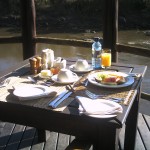 one of his daily drives. Concerned that the Mara was disappearing and that the government was not doing enough to protect it, the Masai approached Heath in 1999. He set up the conservancy, a private non-profit company, in 2001, and supervises the area of the Mara known as the Mara Triangle.
one of his daily drives. Concerned that the Mara was disappearing and that the government was not doing enough to protect it, the Masai approached Heath in 1999. He set up the conservancy, a private non-profit company, in 2001, and supervises the area of the Mara known as the Mara Triangle.
As he led me down tracks laid by his organisation in order to deter the invasions of illegal off-road driving, I could see that the Mara Triangle is in excellent hands. He talked about the land as if it were his lover. Any signs of abuse or violation seem to strike a chord deep within this quiet man’s heart. He pointed out various lodges’ jeeps, telling me that, before tourism figures slumped after the election violence of 2007, the industry generated up to $3 million (€2.2 million) a year for the conservancy from park entry fees. Even though business is picking up again, he still has concerns.
“Tourism is all about making money,” says Heath. “But it’s time the tourism industry invests in its product, which none of them wants to do. We need more guide training and less driving up a wildebeest’s behind. Some drivers are practically holding on to lion’s tails to get a shot – or a good tip.” Heath praised the work of the Travel Foundation, a UK charity undertaking research into guiding ethics, and has been working on a move to make professional guiding qualifications compulsory. This is due to be put in place this year.
It’s not all work for Heath, though. As he drew to a gentle stop he grabbed his binoculars, then passed them to me, saying to watch the river carefully. Staring right back was a huge crocodile. But his focus was on a herd of zebra about to cross the river. We sat in silence, watching this magical and terrifying piece of natural theatre. The zebras crossed unaware. As the crocodile lunged, they leaped up the dusty bank at top speed, escaping with only a few scratches. I have no shots for my album, though. I was too engrossed to move a muscle. The human influence is never far from Heath’s mind, as one of his colleagues came on the radio. “Got three poachers,” the voice said. Heath smiled: “A good morning’s work.”
I spent the afternoon chatting to the Masai women selling beadwork at our lodge. This is one of the only lodges in the area inviting women in to sell directly to tourists. Many source gift products made outside the Mara, sometimes from outside Kenya, but Olonana’s social-responsibility policy is as committed as its environmental one. I spotted beautiful belts and, with only adult sizes, asked if they had any children’s ones. One woman asked if I had photographs of my children. I flicked through my digital camera. We found one, and she complimented their blue eyes, promising to choose beads to match. She would have the belts ready for the day I was leaving. She also spotted a photograph of my mother, with flaming red Irish hair, a great source of amusement for these women, who die their closely cut hair red with ochre. I was quickly bestowed with beaded gifts. “From this mother to yours,” she said, pressing her precious beadwork into my hand and refusing any money. “Ingamuno,” she said before I even had a chance to thank her.
sometimes from outside Kenya, but Olonana’s social-responsibility policy is as committed as its environmental one. I spotted beautiful belts and, with only adult sizes, asked if they had any children’s ones. One woman asked if I had photographs of my children. I flicked through my digital camera. We found one, and she complimented their blue eyes, promising to choose beads to match. She would have the belts ready for the day I was leaving. She also spotted a photograph of my mother, with flaming red Irish hair, a great source of amusement for these women, who die their closely cut hair red with ochre. I was quickly bestowed with beaded gifts. “From this mother to yours,” she said, pressing her precious beadwork into my hand and refusing any money. “Ingamuno,” she said before I even had a chance to thank her.
The next day I went on a cultural tour of Olonana Masai village, with which the lodge has a close affiliation. The lodge recently confirmed that it will be spreading its cultural tours more widely, to other villages, and contributing to the recently formed Mara Triangle Maasai Villages Association. This is a Masai-run sustainable-tourism enterprise, also supported by the Travel Foundation, that ensures tourist income goes directly to the villages and is spent according to democratic voting between all villagers.
I was so curious about these people at this stage that any discomfort about “voyeuristic tourism” had long been dispelled. I was right not to be uncomfortable. The elder who showed us around was open to all questions and proud to share the knowledge and living traditions of his rich culture – such as having to bow down low when entering a person’s house, out of respect to any elders. This is why all thresholds into the village and each house are so low.
He also taught us about the Masai’s dependence on wild herbs, such as Kenya greenhat, the bark of which is used to treat malaria and the twigs of which are used as toothbrushes. He explained about the Masai’s dependence on cattle for everything, from food to building materials (the houses are made from wood and cow dung). We were honoured with dancing and singing, and invited to hold hands and join the dance circle. The Masai have a knack of putting you at your ease. It was reassuringly reminiscent of being pulled up to join a céilí back at home.
You don’t have to “do” things all the time at Olonana. I spent the rest of the day in solitary bliss by the pool. I was joined late in the afternoon by an elderly couple, keen to compare notes on the day’s game sightings. When I explained that I had been visiting a Masai village the man’s jaw dropped. “We tried that last year, didn’t we, dear?” he said to his silent wife. “Aren’t their lives disgusting? And such greedy people. One of them lent my wife 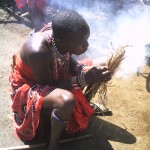 a blanket to keep warm when we did the tour. They’ll try anything to get your money.” I begged to differ, but he wouldn’t hear of it. There’s always one, I thought, as I dived into the pool in an effort to blur out his rant.
a blanket to keep warm when we did the tour. They’ll try anything to get your money.” I begged to differ, but he wouldn’t hear of it. There’s always one, I thought, as I dived into the pool in an effort to blur out his rant.
My final day started early, with a sunrise safari. My wake-up call was unnecessary, with our happy hippos harrumphing and splashing loudly, as if to say: “You can’t sleep late in Africa; there is too much to see and do.” The early rise was eased by the flaskful of hot chocolate and home-made cake left on my veranda.
Lucas was my guide again, and, speaking in a whispered tone, as if to respect the peaceful sunrise, he led me back across the reserve. The day was perfect, with the sun rising on one side of the plain and the moon still almost full over the other, both backed by a perfect pale blue sky. Within moments Lucas pointed out a lone wildebeest. “Unusual to see one on his own,” he said. We continued across the plain, stopping to let hundreds of buffalo cross our path at a gorgeously lugubrious pace. As we sat and waited for the train to pass, Lucas pointed out vultures in a tree nearby, flapping their wings in anticipation. “They have spotted a kill,” Lucas said, “but they can’t move yet. Their wings are too heavy with the morning dew. They have to wait until the sun warms them up.”
An hour later, after passing impalas, zebras and giraffes, the radio started to crackle. “Lion,” said an invisible voice. We headed into denser bush, only to discover 10 jeeps doing the same thing. Within minutes we were watching a young male lion eating a wildebeest carcass, seemingly undisturbed by the onlookers. I sat very still and watched him cleaning the victim’s blood off his paws. When he came within about two metres of my open-sided passenger seat I expressed a little concern. “Don’t worry. If he jumps I’ll just wind the window up,” said Lucas. I didn’t laugh. I knew that we were too close and that the driver was not armed in the 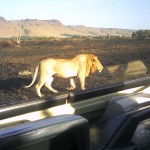 event of an emergency. “Lions don’t attack humans. Don’t worry.” But that’s not what happens in the movies, and at that moment fantasy and reality seemed too close for comfort. The conservancy has a lot of work to do if it wants to convince these drivers that responsible guiding is worthy of a good tip, too.
event of an emergency. “Lions don’t attack humans. Don’t worry.” But that’s not what happens in the movies, and at that moment fantasy and reality seemed too close for comfort. The conservancy has a lot of work to do if it wants to convince these drivers that responsible guiding is worthy of a good tip, too.
We sauntered back to the lodge, passing the same lonesome wildebeest, which was still looking around aimlessly. Then Lucas showed me the cause. The vultures, now fully agile, were tucking into their breakfast of baby wildebeest. Just a few metres away a cheetah was rolling in the grass, licking its lips. The mother wildebeest took a final look, then ran off to rejoin the herd. The grieving process is quick in this part of the world.
My grieving process at leaving it all behind was going to last a bit longer. I had been thoroughly spoiled by Kenyan hospitality, wildlife-viewing and, of course, the unforgettable meetings with the Masai. As I fastened my seatbelt to take off in the 10-seater, a young woman clicked and sighed: “Ah, back to civilisation.” More to be pitied, I told myself, because she clearly had no grasp of what civilisation truly means. I had just been a guest of some of the most civilised people I had ever met. It is not Hollywood‘s Out of Africa at all. It is, quite simply, out of this world.
Catherine stayed at Olonana Camp, Masai Mara, one of Abercrombie and Kent’s Sanctuary Lodges. . See www.abercrombiekent.com for details. Two nights full board from £360, including game activities and visit to Maasai village.
(This article was first published in The Irish Times, 10 January 2009)

